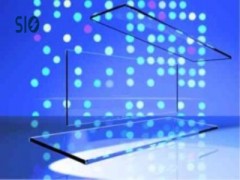 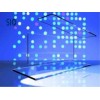 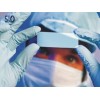 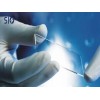   |

Aminosilane coating 氨基硅烷涂层
NEXTERION® Slide A+
Aminosilane coated slides remain the most popular choice for printing PCR products, and long oligonucleotides, despite the emergence of innovative three-dimensional microarray surfaces, and other “active” surface chemistries such as epoxysilane. With it's NEXTERION®Slide A+ SCHOTT is committed to providing the best aminosilane microarray slides on the market.
Overview
|
Type of coating |
Immobilization method |
Typical probes |
Ordering information |
|||
|
NEXTERION®product |
Barcode option |
Item number |
Slides per pack |
|||
|
Aminosilane |
Ionic interaction followed by cross-linking via an additional UV or baking step |
• Long oligonucleotides |
Slide A+ |
None |
1064875 |
25 |
|
Laser |
1064877 |
25 |
||||
|
Key product features |
|||||||||||||||||||||||||||||||||||
|
• Printed slides have a long shelf life |
|||||||||||||||||||||||||||||||||||
|
• Compatible with a wide range of spotting buffers |
|||||||||||||||||||||||||||||||||||
|
• Coatings with uniform aminosilane density |
|||||||||||||||||||||||||||||||||||
|
• Regular spot uniformity and morphology |
|
Typical applications |
|||||||||||||||||||||||||||||||||||
|
• ArrayCGH |
|||||||||||||||||||||||||||||||||||
|
• Transcriptional profiling |
|||||||||||||||||||||||||||||||||||
|
• SNP genotyping |
|||||||||||||||||||||||||||||||||||
|
• Splice variant detection |
|||||||||||||||||||||||||||||||||||
|
• DNA methylation profiling |
|
Suitable probe types |
|||||||||||||||||||||||||||||||||||
|
• BACS or PACs |
|||||||||||||||||||||||||||||||||||
|
• Oligonucleotides ≥ 40 mers |
|||||||||||||||||||||||||||||||||||
|
• Small protein fragments such as peptides |
|||||||||||||||||||||||||||||||||||
|
• cDNA |
Introduction
Aminosilane surfaces provide available amine groups for initial ionic attachment of the negatively charged phosphate groups in the DNA backbone. Conventional wisdom is that longer aminosilane molecules with multiple amino groups produce higher signal-to-background ratios, as their higher positive charge will bind more DNA to the slide surface. However, recent research at SCHOTT has shown that the situation is actually more complicated than this, and that while surfaces with a higher charge do bind more DNA, they are also more difficult to block effectively, resulting in significantly higher non-specific binding. The higher levels of non-specific binding have a negative effect leading to poorer signal-to-background ratios.
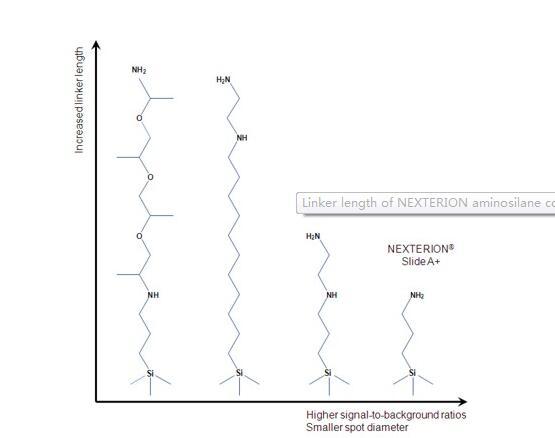
Comparison of aminosilane structures
The aminosilane slide offered by SCHOTT is based on very short chain aminosilanes that demonstrate high signal intensities, and exceptionally low background signals, when compared with other commercially available aminosilane slides.

Immobilization chemistry
Aminosilane coated slides have a high concentration of primary aminogroups available at the surface. These groups become protonated and therefore positively charged when placed in contact with a near-neutral, aqueous solution. Negatively charged probe molecules, such as DNA, will initially form multiple ionic interactions with the positively charged amino surface coating. Additional amino-modifications of the nucleic acids are not required, but such modifications do not interfere with the immobilization. After spotting, the probes are covalently linked to the slide surface by either heating, or a brief exposure to ultraviolet (UV) light. Other types of negatively charged biomolecules may also be coupled to aminosilane surfaces.


Packaging and storage
Format

